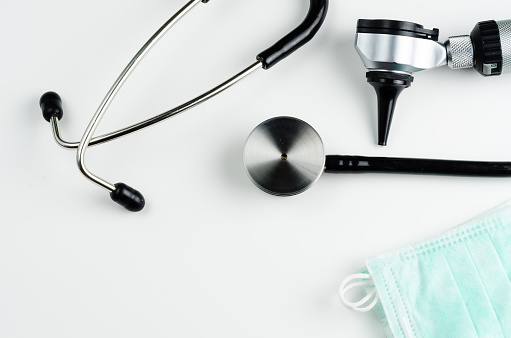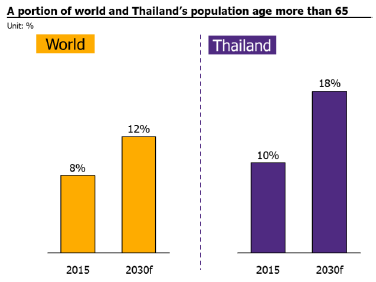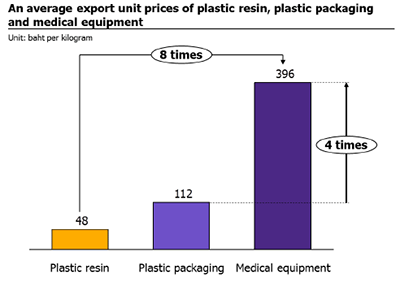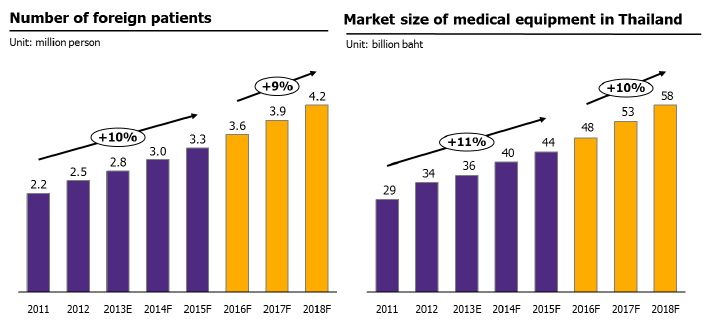Medical equipment… a new growth engine for Thai plastics industry
Plastic is replacing metal, ceramic, and glass in medical equipment production because it is cheaper, more effective, and safer. Its use will further increase with the rising demand for medical equipment as developed nations as well as Thailand are becoming aging societies. As medical equipment can add high value to the plastics industry and lower exposure of plastic products to oil price volatility, it offers attractive potential to help uplift the Thai plastics industry.
Author: Lertpong Larpchevasit

|
Highlight
|
More medical equipment is now produced using plastic because it is more efficient, safer, and cheaper than other base material. The increasing trend of plastic usage in medical equipment is closely watched by analysts around world. It is estimated that the plastic use as raw material for medical equipment production will grow by 7%, while the use of metal, ceramic, and glass will grow at a mere 1-2%. As plastic is cheaper and easier to mold than metal, ceramic, and glass, it therefore has a cost advantage both in terms of raw material and production. Plastic is also more efficient because it can be tailored to specific forms, is lighter than metal and ceramic, and is as durable and transparent as glass. Furthermore, plastic is safer and is able to withstand chemical and radiation sanitation processes—thus it has a reduced risk of contamination from metal corrosion and breakage compared to equipment made from ceramic and glass. Another advantage is that plastic can be mixed with other materials, such as rubber or various bio-chemicals to form composites, increasing its effectiveness and flexibility to meet broader needs.
As leading countries are becoming aging societies, the demand for medical equipment will increase, leading to more usage of plastic. The countries around the world are transitioning to aging societies at greater speed, in particular among developed countries like the U.S., Europe, China, and Japan. It is expected that the portion of the population over 65 around the world will increase from the current share of 8% to 12% by 2030, and the speed of such a transition will drive the demand for medical equipment, which in turn will boost the usage of plastic in medical equipment.
From the industry players’ point of view, the value added from using plastic in medical equipment is greater than exporting resin or semi-finished forms, and offers less exposure to oil price volatility. Although the proportion of plastic used in medical equipment is still considered small when compared to its use in main industries for packaging, automobiles, and electronic equipment, its use in medical equipment can significantly increase its added value. This is because the value of medical equipment exports is higher than the value of plastic packaging or plastic resin by approximately 4 and 8 times, respectively, which allows for a greater profit margin. The use of plastic in medical equipment also benefits from reduced risk from oil price volatility because the price of medical equipment does not vary with oil prices unlike the price of resin or plastic packaging. Such a move to increase the value added of plastic aligns well with the Thai government’s strategy to uplift industrial production values, which will help strengthen Thai manufacturing and exports to be able to sustain growth for the future.
In terms of business potential, EIC believes that Thailand has an advantage due to its robust plastic value chain and rising demand for medical equipment domestically. Thailand has a solid petroleum industry base that is strong throughout the value chain. It is one of the main producers and exporters of plastic in the region, and has production readiness drawing from 3,000 plastic convertors located around the country. Furthermore, due to the advantage in access to agricultural raw materials, Thailand’s capacity for bio-plastic production will also allow Thailand to be able to meet the changing needs for equipment made from environmentally-friendly materials.
Meanwhile, the demand for medical equipment locally is expected to rise steadily at a rate of 10%YOY as the country moves into an aging society. By 2030, the share of the population aged over 65 is expected to increase from its current share of 10% to 18%. Increasing demand for medical equipment will also result from more arrivals of foreign patients, which will continue to grow by 9%YOY. This is because Thailand is the center for healthcare services in ASEAN and has recognized quality and standards in medical treatment. In terms of government policies, businesses will benefit from supportive measures to promote investment in medical equipment. These measures include the waiving of corporate tax for a 5-7 year duration and funding for research and development to support industry upgrades. Moreover, the government’s goal to push Thailand as Asia’s Medical Hub by 2020 will further support the expansion of the demand for Thai medical equipment.
Nevertheless, research and development in related technology and accreditation of high safety standards remain the key challenge to investment in enhancing the medical equipment industry. Medical equipment currently produced in Thailand primarily uses low to medium level technology and is not highly valuable, such as medical gloves, syringes, and IV tubes. On the other hand, more sophisticated medical equipment such as prosthesis, x-ray, and scanning equipment that requires more advanced technology and higher safety standards is imported from leading producers like Japan, the U.S., and Germany. In 2015, the value of medical equipment imported into Thailand was 3.7 billion U.S. dollars, which far exceeds the country’s medical equipment export value of 550 million U.S. dollars. Thai operators thus need to seek business partners that are leaders in technology that can support joint research efforts and the development of technology and safety standards. This will upgrade the medical equipment industry in Thailand and lower the cost of the import of expensive medical equipment, whilst also opening opportunities for new producers and exporters of medical equipment to enter the market.
|
|
|
|
|
Figure 1: The increasing share of elderly around the world and in Thailand will drive the demand for medical equipment.

Source: EIC analysis based on data from the UN.
Figure 2: Medical equipment adds greater value to plastics than plastic resin and semi-finished plastic products by 4 to 8 times.

Source: EIC analysis based on data from the Ministry of Commerce
Figure 3: The medical industry in Thailand will continue to grow as local and foreign patients increase, resulting in more demand for medical equipment

Source: EIC analysis based on data from the Ministry of Public Health